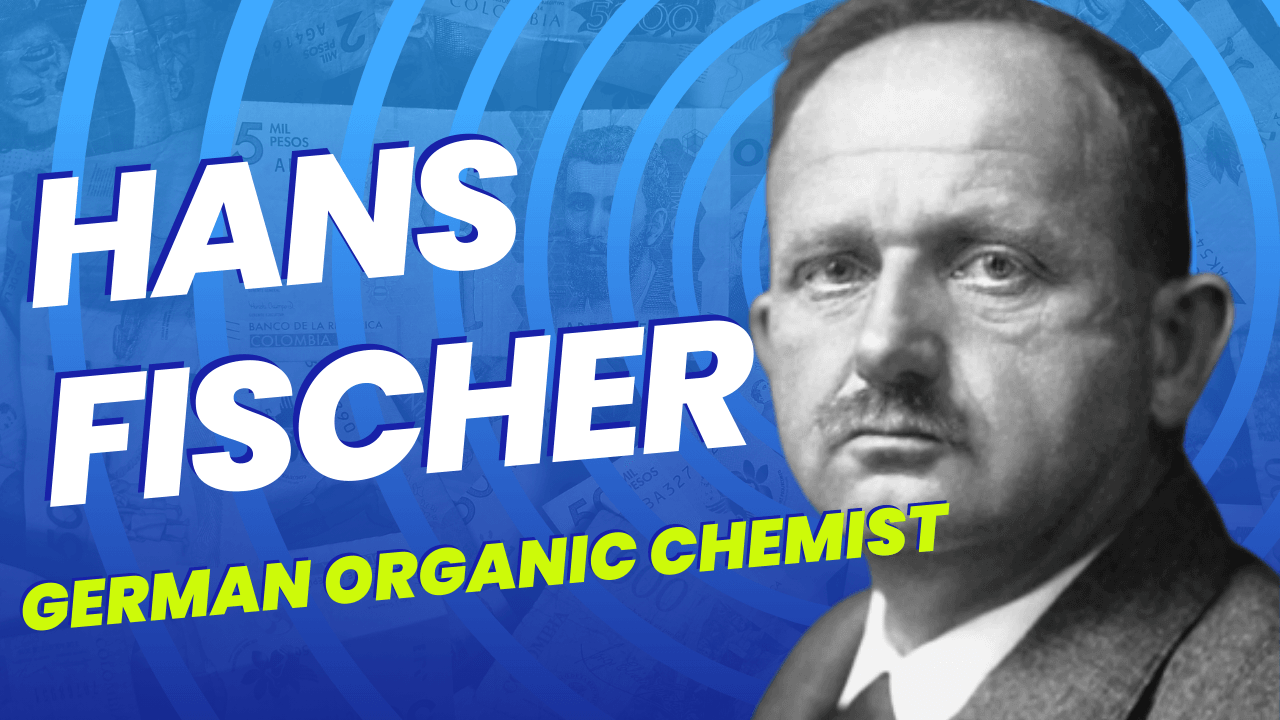Explore the remarkable life of Hans Fischer, Nobel laureate in Chemistry (1930). From groundbreaking hemin synthesis to unraveling chlorophyll’s secrets, delve into the legacy of this visionary organic chemist. 🧪🌿

Hans Fischer; (1881-1945), German organic chemist, who won the 1930 Nobel Prize in chemistry for his analysis and synthesis of hemin (a crystalline product of hemoglobin) and for his work on chlorophyll. Fischer provided much of the modern knowledge of the porphyrins, bile pigments, and chlorophyll; common to all of these are compounds containing four pyrrole nuclei, either in a ring (porphyrins) or in linear form (bile pigments). His great work, Die Chemie des Pyrrols, which Fischer and his pupil H. Orth published in four parts in 1937, remains the standard reference in this field. As James Conant said when Fischer was awarded an honorary degree at Harvard in 1937, “he taught us what makes blood red and grass green.”
Life:
Hans Fischer (1881–1945) was a renowned German chemist known for his significant contributions to the field of organic chemistry. Here’s a brief overview of Hans Fischer’s life:
- Early Life and Education:
- Hans Fischer was born on July 27, 1881, in Höchst, Germany.
- He studied chemistry at the University of Marburg and later earned his Ph.D. in 1904 from the University of Berlin.
- Academic Career:
- Fischer began his academic career as an assistant at the University of Berlin.
- He worked under Emil Fischer (unrelated), a Nobel laureate, and collaborated with him on research.
- In 1911, Hans Fischer became a professor of organic chemistry at the Technical University of Munich.
- Heme and Chlorophyll Research:
- Fischer’s groundbreaking work centered around the chemistry of hemin and chlorophyll.
- In 1929, he successfully synthesized hemin, a component of hemoglobin, which played a crucial role in understanding the structure of blood.
- His extensive research on chlorophyll, the green pigment in plants responsible for photosynthesis, significantly advanced the understanding of plant biochemistry.
- Nobel Prize in Chemistry:
- Hans Fischer was awarded the Nobel Prize in Chemistry in 1930 for his work on the constitution of hemin and chlorophyll and the synthesis of hemin.
- His contributions were instrumental in unraveling the complex structures of these vital biological pigments.
- Later Years and Legacy:
- Despite facing challenges during the Nazi era in Germany, Fischer continued his research.
- He continued to work at the University of Munich until his retirement in 1945.
- Hans Fischer passed away on March 31, 1945.
Hans Fischer’s legacy endures through his pioneering work in organic chemistry, particularly in the understanding of the structures and functions of hemin and chlorophyll. His contributions have had a lasting impact on biochemistry and our comprehension of essential biological processes.
Contributions to Science:
Hans Fischer made significant contributions to the field of science, particularly in organic chemistry. Here are some of his notable contributions:
- Hemin Synthesis:
- Fischer successfully synthesized hemin in 1929. Hemin is a component of hemoglobin, the oxygen-carrying pigment in red blood cells.
- His synthesis of hemin played a crucial role in understanding the structure of blood and contributed to advancements in the study of hemoglobin.
- Chlorophyll Research:
- Fischer conducted extensive research on chlorophyll, the green pigment in plants essential for photosynthesis.
- He made significant strides in elucidating the complex structure of chlorophyll, contributing to the understanding of the process by which plants convert light into energy.
- Nobel Prize in Chemistry (1930):
- Fischer was awarded the Nobel Prize in Chemistry in 1930 for his research on the constitution of hemin and chlorophyll, as well as for the synthesis of hemin.
- This recognition highlighted the importance of his work in advancing the understanding of the molecular structures of biologically crucial compounds.
- Porphyrin Research:
- Fischer’s work extended to the study of porphyrins, a class of organic compounds that includes hemin and chlorophyll.
- His investigations into the structures and properties of porphyrins contributed significantly to the broader field of organic chemistry.
- Synthetic Chemistry:
- Fischer’s expertise in synthetic chemistry, particularly in the realm of complex biological molecules, showcased the potential for creating these substances in the laboratory.
- His synthetic achievements paved the way for further advancements in the chemical synthesis of organic compounds.
- Teaching and Academic Leadership:
- Fischer’s role as a professor and academic leader at the Technical University of Munich provided guidance and inspiration to numerous students and researchers.
- His influence on the next generation of scientists extended beyond his individual research contributions.
Hans Fischer’s work laid the foundation for advancements in biochemistry and organic chemistry, with applications in medicine, biology, and environmental science. His dedication to unraveling the mysteries of complex organic molecules left an indelible mark on the scientific community.